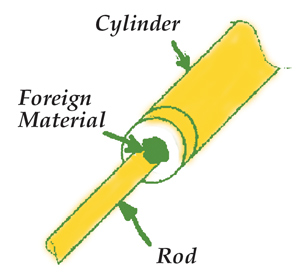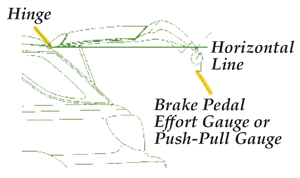This bulletin provides information to properly diagnosis Subaru rear gate stays and also avoids unnecessary replacement of non-failed stays.
Applicability:
• 1998-2002 Forester
• 2000-current Legacy/Outback wagon
• 2002-current Impreza wagon
Repair Procedure: 1. Check the lower end of the rear gate stay for foreign material. If foreign material (i.e. sand particles) gets lodged at the end of the cylinder, it will cause the gas within the cylinder to leak (see Fig. 1). If foreign material is found to be lodged at the end of the cylinder, the cylinder should be replaced.
1. Check the lower end of the rear gate stay for foreign material. If foreign material (i.e. sand particles) gets lodged at the end of the cylinder, it will cause the gas within the cylinder to leak (see Fig. 1). If foreign material is found to be lodged at the end of the cylinder, the cylinder should be replaced.
Note: Read all cautions prior to diagnosing and proper disposal as listed in the applicable service manual.
2. Measurement Check: If you cannot determine which stay may have leaked, they can be checked separately using the following method. A push-pull or brake pedal effort gauge should be used. Each stay needs to be checked individually.
Note: If you’re using a brake pedal effort gauge, it’s advisable to put duct tape on the gauge on the area that will come in contact with the vehicle to protect the painted surface of the vehicle’s rear gate.
 3. Disconnect one stay (refer to the applicable service manual) at a time. Be sure to zero the needle or gauge on your measuring device before proceeding with any testing. Using the brake pedal effort gauge, measure the load by placing the gauge at the lower edge of the rear gate (see Fig. 2). Push up on the rear gate using the gauge and stop when the gate edge is parallel (horizontal) with the rear gate hinge. Record your measurement (see Fig. 2).
3. Disconnect one stay (refer to the applicable service manual) at a time. Be sure to zero the needle or gauge on your measuring device before proceeding with any testing. Using the brake pedal effort gauge, measure the load by placing the gauge at the lower edge of the rear gate (see Fig. 2). Push up on the rear gate using the gauge and stop when the gate edge is parallel (horizontal) with the rear gate hinge. Record your measurement (see Fig. 2).
Compare your measurements with the ones on the chart to determine if replacement is necessary. If the measurement is within specification, reinstall the removed stay and remove the opposite one.
4. Repeat the measuring procedure. If both stays are within specification, no replacement is necessary.
5. The chart below provides specifications to determine if the rear gate stay(s) has failed.
Note: The values in the chart below will vary slightly depending upon ambient temperatures. Failed values listed are that of a stay where the gas has completely leaked out. Values will vary depending upon the amount of remaining gas in the cylinder.
Courtesy of IDENTIFIX.
For more information, visit www.identifix.com.













